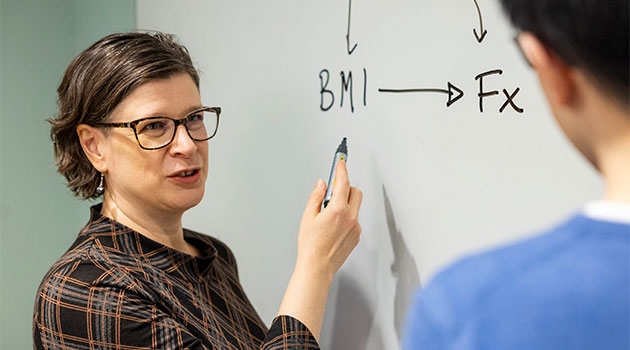How diseases are affected by our lifestyle
Researcher profile
The number of overall fractures is higher in Sweden than in many other countries, but why are Swedes breaking their hip joints more than any other country in the world? Liisa Byberg, Professor of Medical Epidemiology, conducts research in the field of epidemiology – the study of the spread of disease throughout our population.
The epidemiological method involves mapping and describing special patterns within the population through observational studies. Byberg’s research is focused on lifestyle factors and how they are connected to various diseases, such as cardiovascular disease, diabetes and the risk of bone fractures.
Photo: Mikael Wallerstedt
“Sweden is among the top countries in terms of fractures, and we break our hip joints more often than the rest of the world,” explains Byberg. “There are several theories about why this is the case; do we get insufficient sunlight leading to a vitamin D deficiency? Could it be Sweden’s long winters with lots of snow and a greater risk of slipping? Or is there some other significant aspect, given that Finland has a lower incidence of hip fractures despite being located on the same longitude and experiencing more snow?”
Link between good health, food and exercise
Greater expertise is helpful in targeting preventive initiatives and measures from other countries’ authorities and thus changing behaviours across society. For example, dietary advice from the National Food Agency or the Food and Drug Administration in the US can improve public health over the long term.
“We’ve studied factors such as what we eat and how much physical activity we commit to and how these aspects are connected to the risk of a hip fracture. People who eat a Mediterranean diet have a lower risk of hip fracture than those who don’t follow that diet, something which also applies to cardiovascular diseases. We also believe that there are several common mechanisms between cardiovascular diseases and the risk of fracture.”
Physical activity through training strengthens the muscles and gives you better balance and reflexes for supporting yourself when you fall, which can influence the risk of fracture. But is it too late to start exercising at a more mature age?
“The incentive for changing your activity habits is different for different people,” explains Byberg. “ULSAM is a famous study among clinical researchers in Uppsala which started back in the 1970s. In it we can see that those who increased their physical activity between the ages of 50 and 70 had a lower risk of dying from heart-related ailments than those who did not. So despite the rough categories, we can see a connection to health and that it is not too late to start exercising.”
New epidemiological methods
Byberg’s journey into this research track came about partially by chance, but another major contributing factor was a meeting with a professor who showed a dedication to his subject and an interest in his students.
“I feel it’s important to be curious when working as a university teacher, and to make use of the students’ curiosity too. It inspires me that the doctoral students I teach on doctoral courses are able to use new epidemiological methods together with their unique skills and apply that to their fields of research.”
Research into cause and effect has expanded greatly over the years within international epidemiological research. Causal inference is an interdisciplinary field of research involving statisticians, epidemiologists, economists, demographists and many other collaborating specialists. The 2021 Nobel Prize in Economic Sciences was awarded to two of the leading researchers in this field: Guido Imbens and Joshua Angrist. New methods are also being developed whereby more specific questions are posed about the data, meaning researchers can be clearer in the conclusions they draw.
“A lot is happening as these methods are developed. I hope I will be able to apply new methods to our existing data in order to pose more specific questions about the mechanisms that help us understand how lifestyle factors impact on our health.
“What’s so exciting about being a biomedical practitioner in a clinical and epidemiological research environment is that we can first establish causal relationships and propose potential new hypotheses about what the mechanisms might be, and then other researchers can test those via cellular or animal models or in other fields of research. I think that’s really cool,” concludes Byberg.
Cecilia Yates
Facts about Liisa Byberg
Liisa Byberg, Professor of of Medical Epidemiology and Head of the Department of Surgical Sciences.
Place of research at the EpiHub: A network for epidemiological research at the Disciplinary Domain of Medicine and Pharmacy.
Family: Yes.
Leisure activities: I enjoy skiing, particularly on a deserted mountain when it’s –4 and sunny, but also watching skiing.
If I hadn’t become a researcher: It’s important to do something fun, otherwise there’s no point continuing. I studied to be a biomedical practitioner, but I was also interested in engineering physics or cultural studies with a focus on French.
Something that makes me feel proud: Seeing students and doctoral students grow into their role and feeling within themselves that they have developed and become experts in their subject. That makes me feel happy and proud.
Preferred reading: detective novels on holiday or other kinds of fiction.
Dream holiday: Ideally a place with both sea and mountains.
Favourite sweet: Finnish liquorice, it’s so good!
Epidemiology is the study of the distribution, causes and course of disease. The epidemiological method involves mapping and describing the distribution of a disease and special patterns within the population. Practitioners also map risk factors for disease and investigate how such factors are connected to various health conditions and diseases. In this way they can identify groups in the population that could serve as a target group for targeted initiatives, as well as a basis for further investigation of the cause of disease. Epidemiology is not only the study of infectious diseases; it can cover all types of illness, such as diabetes, heart conditions and high blood pressure.

